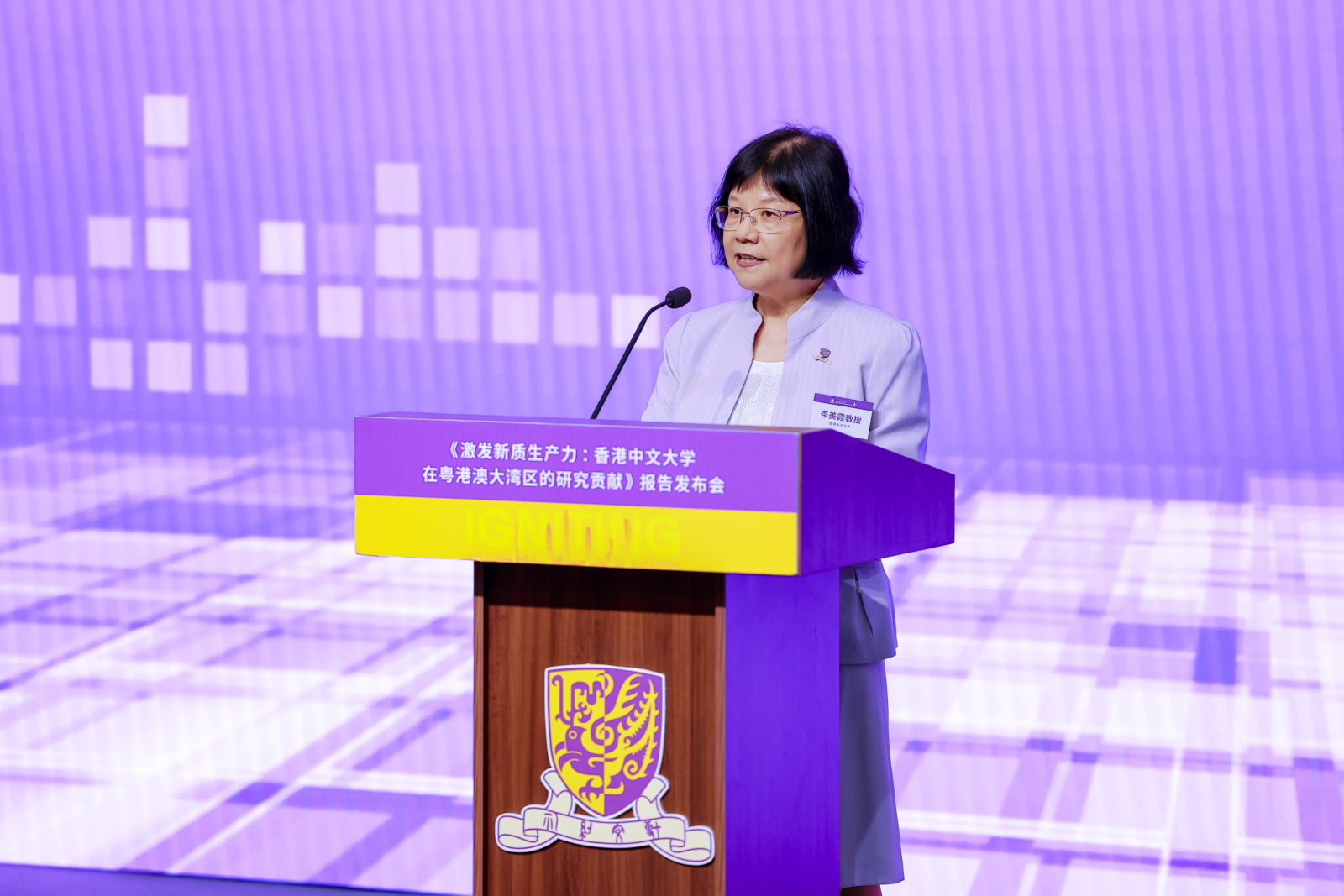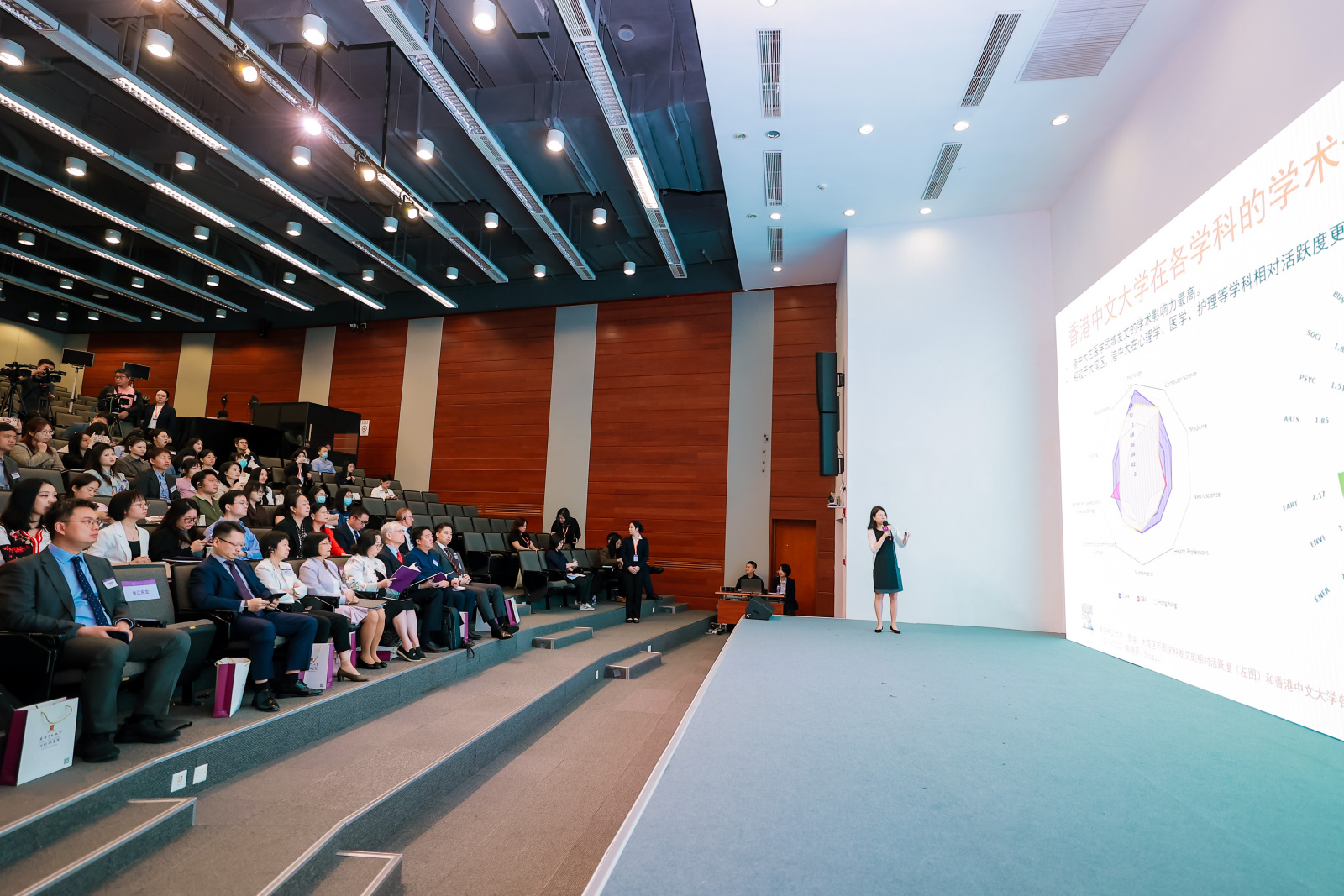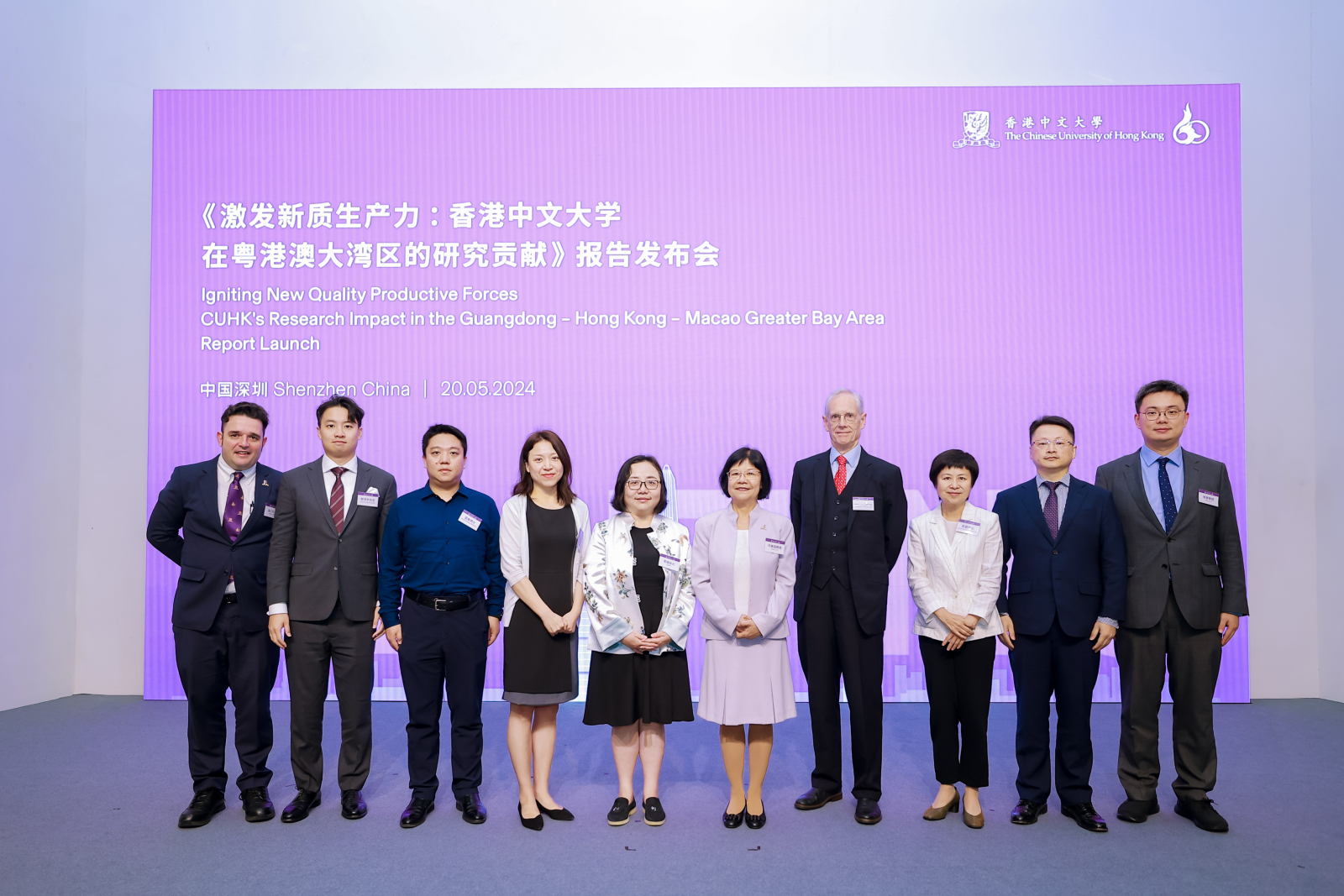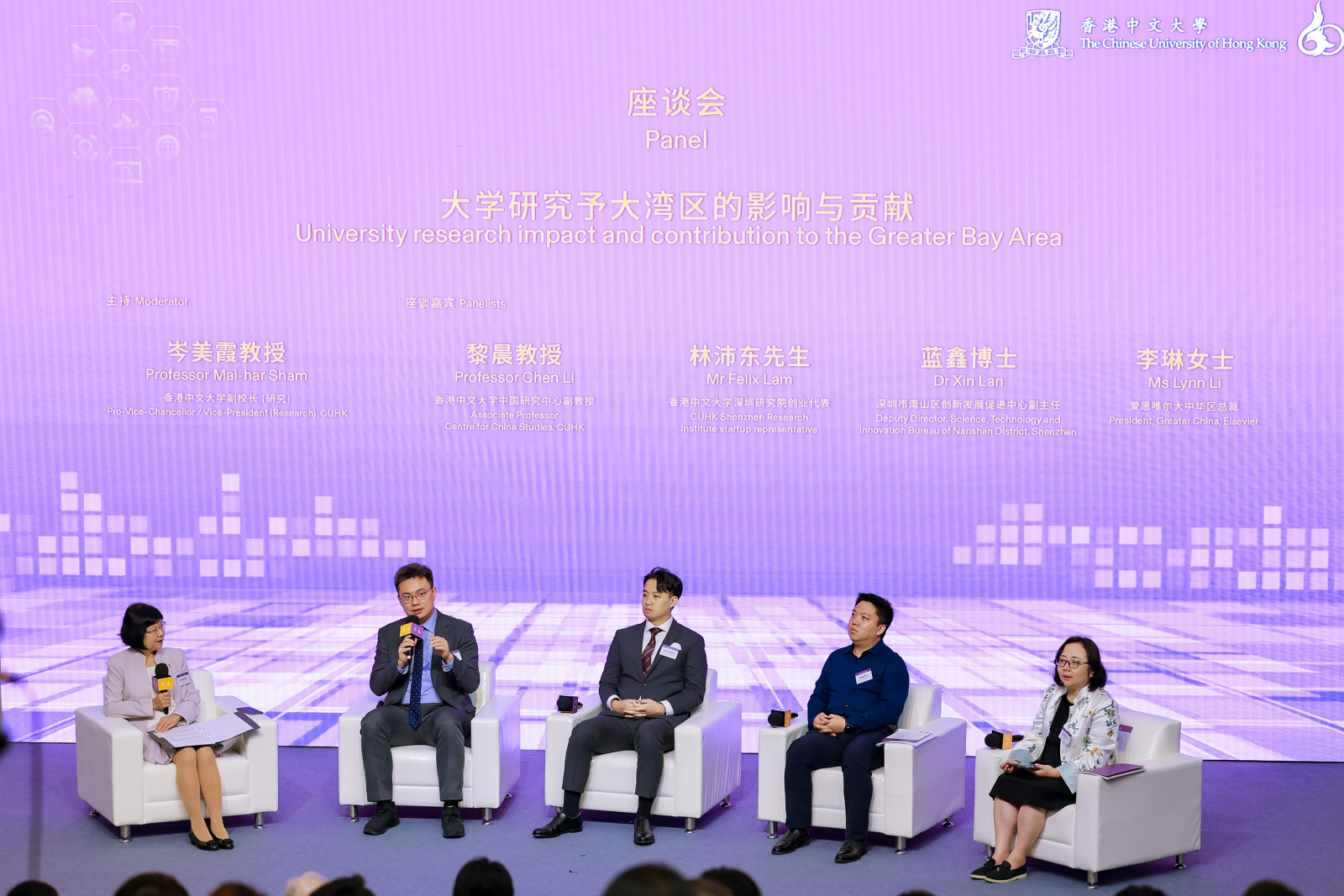- Home
- /
- Media
- /
- Internal News
Landmark CUHK-Elsevier report demonstrates rapid growth of research and development in the GBA
Over the past five years (from 2018 to 2022), research and development in the Guangdong–Hong Kong–Macao Greater Bay Area (GBA) has seen compound annual growth rate (CAGR) of 17.9% for its research output, according to a landmark report commissioned by The Chinese University of Hong Kong (CUHK) and launched today (20 May 2024) at a special forum held in Shenzhen.
The total number of active researchers of the GBA has similarly grown by a CAGR of 19% with the economic powerhouse now home to over 420,000 active scholars which nearly doubled from 2018 to 2022, investigating a diverse range of specialised fields of vital importance to the competitiveness of the regional economy such as engineering, medicine, computer science, materials science, biochemistry, physics and chemistry.
Produced by leading international information and analytics company Elsevier, primarily using data from its abstract and citation database, Scopus, the report analyses megatrends driving research impact in the GBA and examines the impact across a range of key metrics spanning citations, knowledge exchange potential and research collaboration.

CUHK’s Pro-Vice-Chancellor (Research) Professor Sham Mai-har delivered a welcome speech on behalf of the university, expressing gratitude to the Elsevier report which affirms CUHK’s research impact, while also noting the report has offered significant guidance to CUHK in terms of development of the ‘New Quality Productive Forces’.
“This report demonstrates the GBA’s phenomenal growth as a research and development powerhouse. World Bank data says the GBA’s gross domestic product output would make it the world’s eleventh largest economy, and this report shows us that the region’s research outputs are starting to reflect the size and scale of such a dynamic area. If the GBA is going to take the next step and contribute to the development of the New Quality Productive Forces, this report is a powerful reminder that a strong research sector will be essential to that endeavour,” said CUHK’s Pro-Vice-Chancellor (Research) Professor Sham Mai-har.

Dr Yingying Zhou, Head of Research Analytics, China, Elsevier, gave a presentation of the report data and shared her insights during the launch of the report.
The report assesses the performance of CUHK relative to other universities in Hong Kong and the wider GBA with some key data points further benchmarked against national and global averages. Importantly, the report aims to capture Hong Kong’s contribution to the GBA’s research ecosystem and does this by separating Hong Kong’s data and showing this alongside data from the rest of the region.
The report examined research performance of the GBA in five fields of national strategic importance, namely, biomedicine, environmental science, clean energy, artificial intelligence and quantum technology, to assess the region’s contribution to major areas of national development. CUHK accounts for 5.3% of all research in the GBA in biomedicine, demonstrating the importance of the University’s research in driving scholarly discovery in this crucial area for the delivery of the nation’s Healthy China 2030 goals. In addition, CUHK achieved a higher contribution in the field of artificial intelligence, accounting for 5.8% of the research output in the GBA. In all research fields, CUHK’s field weighted citation impact (FWCI, which is a key measure to demonstrate research impact based on the average citations of research in a field) eclipsed averages across the region.
Crucially, the report demonstrated that CUHK has the highest overall FWCI among the most published institutions in the entire GBA, surpassing all the top-producing universities, government research organisations and corporate research institutes. Five out of the ten top producing institutions were Hong Kong-based, with four ranking in the top five. Hong Kong’s FWCI is 27% higher than the GBA’s, per capita publications of its researchers are twice as much, and their publications’ patent citation rates are 29% higher than those of their other GBA counterparts.
Professor Sham added that “the Elsevier report shows that CUHK contributes to 5.4% of the GBA’s total research output and 7.4% of the region’s excellent research output. To put it differently – CUHK accounts for nearly 6% of all research and development in an economy that is larger than South Korea, and the data tells us that we do the highest quality work. This is an impressive achievement for a university which only really got into research intensity in the 1990s.”

Professor Sham Mai-har, Pro-Vice-Chancellor (Research), CUHK (fifth from the right), Professor Nick Rawlins, Pro-Vice-Chancellor (Student Experience), CUHK (fourth from the right), Ms Lynn Li, President of Elsevier (Greater China) (fifth from the left), Dr Rong Chen, Director of Shenzhen Science and Technology Strategic Research and Technology Transfer Promotion Centre (third from the right), Dr Yingying Zhou, Head of Research Analytics, China, Elsevier (fourth from the left), Mr Chao Ai, Vice President of Global Technical Cooperation, Huawei (second from the right), Dr Xin Lan, Deputy Director of Nanshan District Innovation Development Promotion Center (third from the left), Professor Chen Li, Associate Professor, Centre for China Studies, CUHK (first from the right), Mr Felix Lam, CUHK Shenzhen Research Institute startup representative (second from the left), and Mr Laurie Pearcey, Associate Vice-President External Engagement & Outreach, CUHK (first from the left) in a group photo.
Underscoring the importance of collaboration in driving high-quality research, the report examines collaborative research in Hong Kong, the GBA, and specifically analyses the size and mode of CUHK’s research collaborations. The data found that 30.2% of the GBA’s research collaborations are with international partners (based on collaborative publications), while this figure was 41.1% for Hong Kong overall, and 42.9% for CUHK, indicating the strength of the University in driving research collaborations relative to peers in Hong Kong and the wider region. Nearly 40% of CUHK’s research output involved the participation of GBA institutions, among which, 60% were co-authored with GBA institutions and those beyond the region, indicating the University’s commitment to bridging the region with its partners further afield.
Speaking about this data, Professor Sham said the analysis “points to Hong Kong’s role as a superconnector and echoes the Central Government’s call for the Special Administrative Region to position itself as a uniquely international innovation and technology hub. CUHK will redouble its efforts to ensure that it acts as a true bridge between the mainland and the world, and these numbers are a powerful reminder of the importance of our historic mission ‘to connect China and the West’.”
Professor Sham concluded that “the data further demonstrates the mutually beneficial nature of collaborating with our GBA partners. The report maps the uplift in citation impact experienced by our partners from co-authoring with CUHK. Nine out of ten achieved the FWCI ratio higher than one and eclipsing the FWCI of their own overall research, which indicates the value our GBA partners gain from working with CUHK. There was one case which saw the FWCI of its collaborations with CUHK more than 6.5 times higher than that of its overall research”.
“The report is a result of the successful collaboration between Elsevier and CUHK,” said Ms Lynn Li, President of Elsevier (Greater China). “We intend to showcase the research impact of the GBA and support the scientific community in the region along their path of research and innovation, thereby enabling technological advancement to better serve society as a whole. As an academic publishing and research information analytics company that publishes top global academic journals such as The Lancet and Cell, operates authoritative research databases like ScienceDirect and Scopus, and consistently introduces AI tools applicable to a diverse range of research scenarios, Elsevier takes pride in its unique digital ‘publishing content plus information analytics’ dual-wheel model and is honoured to be part of the research ecosystem of the GBA. We will continue to innovate with our research partners in the GBA and look forward to the fruitful outcomes of scientific research and innovation in the region.”

Moderated by Pro-Vice-Chancellor (Research) Professor Sham Mai-har, CUHK (first from the left), the panel discussion titled ‘University’s research impact and contribution to the Greater Bay Area’ was participated by Professor Chen Li, Associate Professor, Centre for China Studies, CUHK (second from the left), Mr Felix Lam, CUHK Shenzhen Research Institute startup representative (third from the left), Dr Xin Lan, Deputy Director of Nanshan District Innovation Development Promotion Center (second from the right) and Ms Lynn Li, President of Elsevier (Greater China) (first from the right) who shared their thoughts and insights on innovation, research and development, and their applications during the session.
The report was launched at a special event at the CUHK Shenzhen Research Institute under the theme of “Igniting New Quality Productive Forces: CUHK’s Research Impact and Contribution to the GBA”. The event featured a keynote address from Huawei’s Global Vice-President Technology Cooperation Dr Ai Chao titled “Joint Design Innovation Paradigm to Promote Industry and Academia Collaboration and Achieve Innovative Breakthroughs”, and a panel session with representatives from the Shenzhen Government and a CUHK start-up company.
reference:https://www.cpr.cuhk.edu.hk/en/press/igniting-impact-for-new-quality-productive-forces-landmark-cuhk-elsevier-report-demonstrates-rapid-growth-of-research-and-development-in-the-gba/
相关新闻详情
09 December 2025
港中大研究院(深圳)有限公司健身房及更衣室改造装修项目招标采购公告
25 November 2025
The Proposal Defense Meeting of Postdoctoral Fellow HongMei from CUHK SZRI Was Successfully Held







